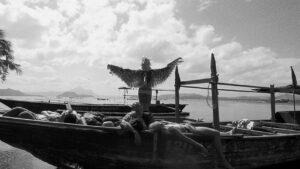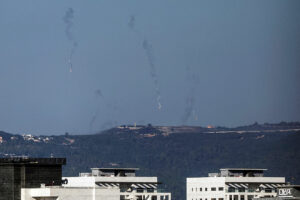Lady of the lake

Movie ReviewEssential Truths Of The LakeDirected by Lav Diaz
CALL Lav Diaz’s latest film Essential Truths of the Lake a prequel to his When the Waves are Gone (Kung Wala Nang Mga Alon 2022); call the film a deeper dive into Diaz’s returning character Hermes Papauran, the oft-described “greatest Filipino investigator ever.”
Peter Debruge, in his faintly sarcastic review in Variety, chided the film’s failure “to show what makes (Hermes) the ‘greatest’” — I submit that when put in context the assertion makes more sense. As I noted in Diaz’s earlier Norte the End of History, genius police officers aren’t really a thing in the Philippines, if anything their investigations are notorious for being unreliable and slow, that they often play the key role in any government cover-up to follow. Crime is rarely an intricate, much less rational, enterprise in this country; more often than not the killings are committed by casual contractors given money with tacit approval of law enforcers, done through a chain of middlemen — the higher the rank, the longer the chain (good luck trying to trace anything to former president Duterte, who is likely most guilty of the same crime as former president Trump: he pushed people to do their worst, and they more than did his bidding). Criminal methods are erratic, investigative procedures even more so, and results are dependent not on the brilliance of the criminal or his pursuer but on incompetence (from both sides) and sheer happenstance.
Hermes does confront the apparent power behind the scenes, Bart Guingona’s Jack Barquero. Sparring verbally over cups of rice coffee, with the waters of Taal Lake as background, Hermes sketches Barquero’s background for him. “Very good,” Barquero admits, but asks the million-peso question: “Can you solve the case (unspoken: can you catch me?)?” Hermes’ answer is as elliptical as anything Diaz has put out: the question, he asserts, is too broad, as broad as the lake behind Barquero.
Debruge is more on target guessing “what really matters isn’t solving cases but refusing to abandon them.” Call Diaz a practitioner of the Sisyphean School of Suffering: you pick your stone, you exert endless effort rolling it up a hill; you may never achieve your goal but you don’t give up and perhaps the strain is good for your soul (alternate title: School of Extreme Spiritual Aerobics).
No extra points for guessing that Hermes Papauran (the surname simply meaning “mythological,” the given name taken from the herald of Greek gods, and a psychopomp — a conductor of souls to the afterlife [you might say Hermes is obsessed because he’s lost track of this particular soul and can’t rest till he’s guided it to its correct destination]) is Diaz’s avatar — unlike Hermes, however, Diaz has had the luck to actually finish his works and put them out there, for us in turn to persevere watching.
Actually, Diaz doesn’t seem to create characters so much as he fashions statues, marble figures with names appended to their respective pedestals (“integrity,” “malice,” “chaos”), and he relies on or works with the actors to humanize them. Hence Hermes, as allegorically loaded as he is, is rendered all too human flesh by John Lloyd Cruz with understated intensity: in Hermes’ conversation with his colonel (a tremendous Agot Isidro) he admits to his superior the distress of watching innocents gunned down. His memories — staged by Diaz with surreal flair — are indistinguishable from nightmares, his confessions skittering so close to hysterical rambling the colonel is forced to shut him down. All this in medium shot, at a picnic table over bowls of egg noodles, framed by a row of trees and a view of the sea — Diaz loves underplaying the melodrama, and in passages like this (and a later moment when the colonel, with her back to Hermes, attempts to hide her true feelings from him) the combination works well.
Later we hear Hermes on the phone talking to his son Nick and glean from details and snatches of dialogue that Hermes’ domestic situation is not much more tranquil than his workplace (or rather tranquil in the way a frozen lake is tranquil; after affectionately exchanging words with his son he asks to speak with his wife, who hangs up). Later we see Hermes sit down with Melchora (Susan Africa, also very good) and admit to her that, grateful as he is for the food she cooks for him, he’s on a restrictive diet due to skin asthma — the somatic manifestation of his guilt that would grow immensely worse in the next film.
Diaz’ and cinematographer Larry Manda’s work in black and white only grows more impressive with every feature: the outdoor dance sequence glows an unearthly white, nighttime shadows have a velvety depth. Diaz lets a shot run on for minutes, with lightly off-balanced framing; part of the fascination of his images, despite the leisurely pace, is that you’re teased into trying to figure out how it’s off-balanced, to the point that you can’t take your eyes off the screen (once you do figure it out, you’re then teased into trying to figure out why).
He’s also been working on sound design, and here the twisted cries and whispers coming from his track during the nightmare sequences are an effective low-cost way of suggesting Hermes’ torment.
As Esmeralda Stuart, the woman in the center of Hermes’ Philippine Eagle cold case, Shaina Magdayo is the prized porcelain figurine in Diaz’ collection. Impossibly beautiful, she works against that beauty to suggest the sad lost soul trying to make her voice heard, in dance, in theater, in film — she’s suffered abuse but it’s suggested she’s also slept her way to fame; she’s by turns whore, activist, scandal, madonna. What’s the truth? We’re not even sure about the details of her career — is she a dancer, an actress, a celebrity environmental advocate being interviewed for a profile, maybe all three? Diaz through Hermes through documentary filmmaker Jane Liway (played, again excellently, by Hazel Orencio) approach her from many angles and invites her again and again to pour her heart out to the camera and still she remains an enigma, a stubborn unknown. Diaz seems to follow Dumas’ dictum and noir’s axiom to “cherchez la femme,” and Shaina’s Esmeralda gives these people, including you, few answers but keeps you watching anyway.
Which may be pushing Hermes over the edge.
At one point he pulls on Esmeralda’s formfitting eagle costume and runs about, spreading wide-fingered wings and frightening the occasional innocent bystander — possibly Diaz poking fun at the superhero genre (Hermes — The Legend Who Would Not Give Up) but you feel there’s more to this relatively brief aside. Diaz earlier showed us folks who might appreciate Hermes’ cross dressing, possibly under the influence of one illegal substance or another, but the man pointedly avoids that crowd — mostly he’s by himself against the vast surrounding landscape, a wild figure against sun-scorched wilderness.
You feel the film is most alive in these moments — that here is where it reveals its freest truest self. There’s the persistent image of the loner and wanderer in Diaz’ films, and you feel as if there’s nothing more he’d like to do than a really, really long film of someone just being out in the world (he almost did that film too — see Heremias Book One: The Legend of the Lizard Princess, sequel [Book Two] still forthcoming). The loneliness Diaz suggests here is both terrifying and exhilarating, and I suspect those who respond to his films feel that pull too, like standing at the edge of a high cliff savoring the urge to jump.
At this point the colonel pulls the plug on the case and Hermes is led away with little protest; then Taal erupts (the center of the lake is a giant caldero) and a more hirsute, more casually dressed Hermes returns, working against all hope to uncover still more clues to Esmeralda’s death (now likely covered by tons of volcanic ash turned by rain into concrete). Hermes is questioned — what’s the point? “That’s the way it goes,” the detective shrugs. “Everything starts from nothing.”
Which makes me question Debruge’s closing assertion in his review (my last reference to the piece, promise) that Diaz “hasn’t lost faith in the (justice) system.” We see Hermes back onsite with mystery buried deeper than before, clearly in violation of his colonel’s orders — gone rogue, or at least surrendered his badge, and he simply can’t let the issue go, so he’s continued as a private citizen.
Later Hermes encounters Diaz’ version of Duterte’s extrajudicial killings (EJKs) where a luckless man is accused of stealing, and a contrast is made between the case that obsesses Hermes and this latest death before him: the former inhabits his mind rent free as the saying goes, and in many ways is the more haunting — the way Marcos’ crimes still obsess us because they remain unpunished, much less unresolved — but we live in the here and now, life goes on, and newer monsters are in our midst. At some point we face our limitations and must make a choice: keep hold, or let go? We know what happens to Hermes — or at least we have a clue, if we’ve seen When the Waves are Gone — but for the end of this chapter in the story at least, Diaz leaves matters for us to decide.



